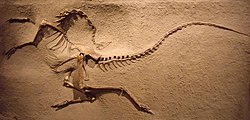Ornithomimids
| Ornithomimosaurs Temporal range: Cretaceous, 140–66 Ma |
|
|---|---|
 |
|
| Cast of an ornithomimid (Struthiomimus altus) skeleton, Royal Tyrrell Museum | |
| Scientific classification | |
| Kingdom: | Animalia |
| Phylum: | Chordata |
| Clade: | Dinosauria |
| Order: | Saurischia |
| Suborder: | Theropoda |
| Clade: | Maniraptoriformes |
| Clade: |
†Ornithomimosauria Barsbold, 1976 |
| Subgroups | |
|
†"Dryosaurus" grandis |
|
| Synonyms | |
|
|
†"Dryosaurus" grandis
†Harpymimus
†Hexing
†Kinnareemimus
†Nedcolbertia
†Nqwebasaurus
†Pelecanimimus
†Shenzhousaurus
†Thecocoelurus
†Valdoraptor
†Deinocheiridae
†Ornithomimidae
The Ornithomimosauria, ornithomimosaurs ("bird-mimic lizards") or ostrich dinosaurs are theropod dinosaurs which bore a superficial resemblance to modern ostriches. They were fast, omnivorous or herbivorous dinosaurs from the Cretaceous Period of Laurasia (now Asia, Europe and North America), as well as Africa and possibly Australia. The group first appeared in the Early Cretaceous and persisted until the Late Cretaceous. Primitive members of the group include Nqwebasaurus, Pelecanimimus, Shenzhousaurus, Hexing and Deinocheirus, the arms of which reached 2.4 m (8 feet) in length. More advanced species, members of the family Ornithomimidae, include Gallimimus, Struthiomimus, and Ornithomimus. Some paleontologists, like Paul Sereno, consider the enigmatic alvarezsaurids to be close relatives of the ornithomimosaurs and place them together in the superfamily Ornithomimoidea (see classification below).
...
Wikipedia
